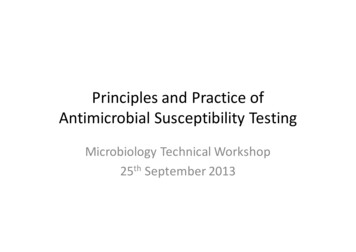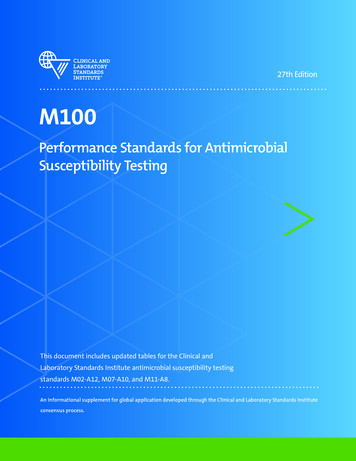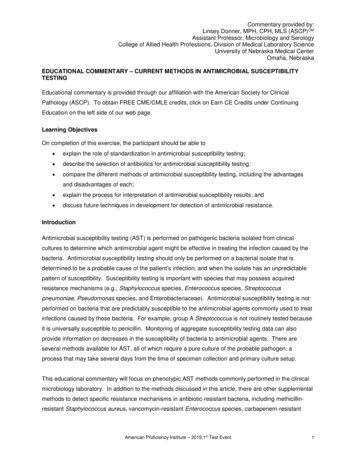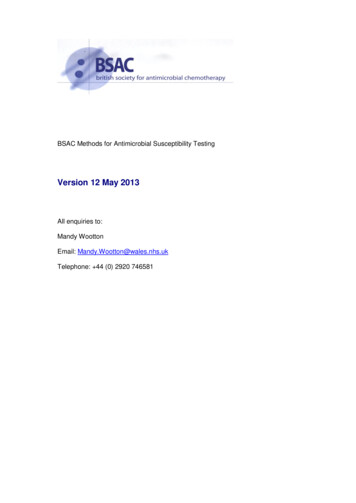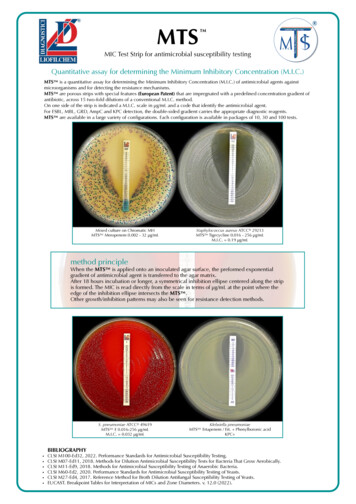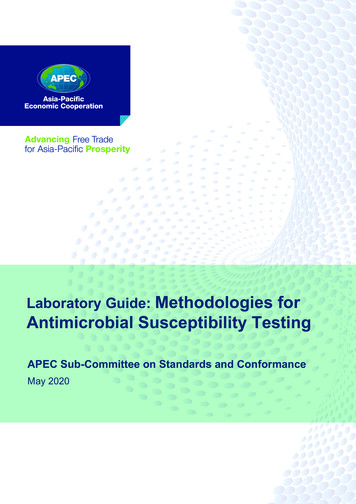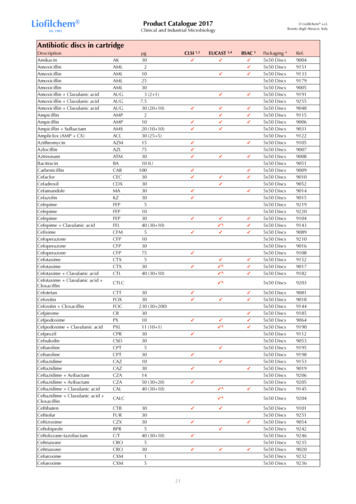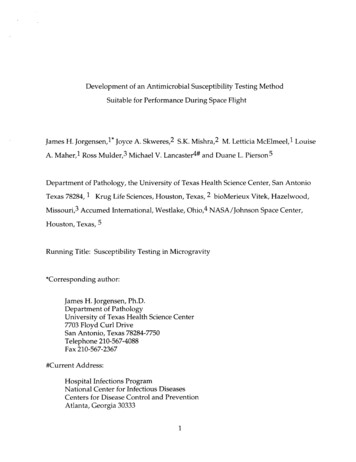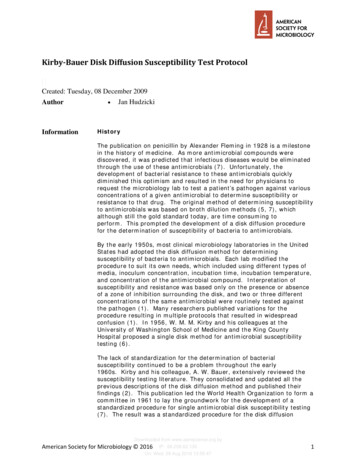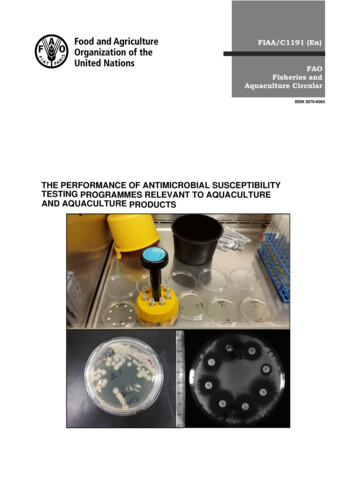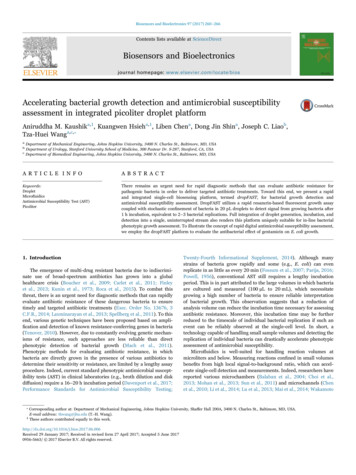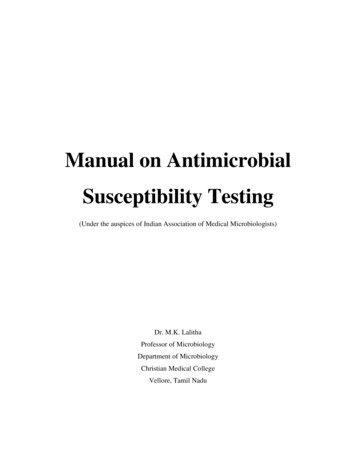
Transcription
Manual on AntimicrobialSusceptibility Testing(Under the auspices of Indian Association of Medical Microbiologists)Dr. M.K. LalithaProfessor of MicrobiologyDepartment of MicrobiologyChristian Medical CollegeVellore, Tamil Nadu
CONTENTSPAGE No.1. Introduction32. Principle43. Factors Influencing Antimicrobial Susceptibility Testing54. Methods of Antimicrobial Susceptibility Testing64.1 Disk Diffusion74.2 Dilution144.3 Dilution And Diffusion.205. Susceptibility Testing Of Fastidious Bacteria216. Errors in Interpretation and reporting Results287. Quality Control in Antimicrobial Susceptibility Testing298. Standard Methods for the Detection of Antimicrobial Resistance.309. Application of Computers in Antimicrobial Susceptibility Testing3910. Selected Bibliography41Annexure43I. Guide lines for Antimicrobial Susceptibility TestingII. Suggested Dilution Ranges for MIC TestingIII. Solvents and Diluents for Antibiotics2
1. IntroductionResistance to antimicrobial agents (AMR) has resulted in morbidity and mortality fromtreatment failures and increased health care costs. Although defining the precise publichealth risk and estimating the increase in costs is not a simple undertaking, there is littledoubt that emergent antibiotic resistance is a serious global problem.Appropriate antimicrobial drug use has unquestionable benefit, but physicians and thepublic frequently use these agents inappropriately. Inappropriate use results from physiciansproviding antimicrobial drugs to treat viral infections, using inadequate criteria for diagnosisof infections that potentially have a bacterial aetiology, unnecessarily prescribing expensive,broad-spectrum agents, and not following established recommendations for using chemoprophylaxis. The availability of antibiotics over the counter, despite regulations to thecontrary, also fuel inappropriate usage of antimicrobial drugs in India. The easy availabilityof antimicrobial drugs leads to their incorporation into herbal or "folk" remedies, which alsoincreases inappropriate use of these agents.Widespread antibiotic usage exerts a selective pressure that acts as a driving force in thedevelopment of antibiotic resistance. The association between increased rates ofantimicrobial use and resistance has been documented for nosocomial infections as well asfor resistant community acquired infections. As resistance develops to "first-line"antibiotics, therapy with new, broader spectrum, more expensive antibiotics increases, but isfollowed by development of resistance to the new class of drugs.Resistance factors, particularly those carried on mobile elements, can spread rapidly withinhuman and animal populations. Multidrug-resistant pathogens travel not only locally butalso globally, with newly introduced pathogens spreading rapidly in susceptible hosts.Antibiotic resistance patterns may vary locally and regionally, so surveillance data needs tobe collected from selected sentinel sources. Patterns can change rapidly and they need to bemonitored closely because of their implications for public health and as an indicator ofappropriate or inappropriate antibiotic usage by physicians in that area.3
The results of in-vitro antibiotic susceptibility testing, guide clinicians in the appropriateselection of initial empiric regimens and, drugs used for individual patients in specificsituations. The selection of an antibiotic panel for susceptibility testing is based on thecommonly observed susceptibility patterns, and is revised periodically.2. PrincipleThe principles of determining the effectivity of a noxious agent to a bacterium were wellenumerated by Rideal ,Walker and others at the turn of the century, the discovery ofantibiotics made these tests(or their modification)too cumbersome for the large numbersof tests necessary to be put up as a routine. The ditch plate method of agar diffusion usedby Alexander Fleming was the forerunner of a variety of agar diffusion methods devisedby workers in this field .The Oxford group used these methods initially to assay theantibiotic contained in blood by allowing the antibiotics to diffuse out of reservoirs in themedium in containers placed on the surface.With the introduction of a variety of antimicrobials it became necessary to perform theantimicrobial susceptibility test as a routine. For this, the antimicrobial contained in areservoir was allowed to diffuse out into the medium and interact in a plate freshlyseeded with the test organisms.Even now a variety of antimicrobial containingreservoirs are used but the antimicrobial impregnated absorbent paper disc is by far thecommonest type used. The disc diffusion method of AST is the most practical methodand is still the method of choice for the average laboratory. Automation may force themethod out of the diagnostic laboratory but in this country as well as in the smallerlaboratories of even advanced countries, it will certainly be the most commonly carriedout microbiological test for many years to come. It is, therefore, imperative thatmicrobiologists understand the principles of the test well and keep updating theinformation as and when necessary. All techniques involve either diffusion ofantimicrobial agent in agar or dilution of antibiotic in agar or broth. Even automatedtechniques are variations of the above methods.4
3. Factors Influencing Antimicrobial Susceptibility TestingpHThe pH of each batch of Müeller-Hinton agar should be checked when the medium isprepared. The exact method used will depend largely on the type of equipment available inthe laboratory. The agar medium should have a pH between 7.2 and 7.4 at room temperatureafter gelling. If the pH is too low, certain drugs will appear to lose potency (e.g.,aminoglycosides, quinolones, and macrolides), while other agents may appear to haveexcessive activity (e.g., tetracyclines). If the pH is too high, the opposite effects can beexpected. The pH can be checked by one of the following means:*Macerate a sufficient amount of agar to submerge the tip of a pH electrode.*Allow a small amount of agar to solidify around the tip of a pH electrode in a beakeror cup.*Use a properly calibrated surface electrode.MoistureIf, just before use, excess surface moisture is present, the plates should be placed in anincubator (35 C) or a laminar flow hood at room temperature with lids ajar until excesssurface moisture is lost by evaporation (usually 10 to 30 minutes). The surface should bemoist, but no droplets of moisture should be apparent on the surface of the medium or on thepetri dish covers when the plates are inoculated.Effects of Thymidine or ThymineMedia containing excessive amounts of thymidine or thymine can reverse the inhibitoryeffect of sulfonamides and trimethoprim, thus yielding smaller and less distinct zones, oreven no zone at all, which may result in false-resistance reports. Müeller-Hinton agar that isas low in thymidine content as possible should be used. To evaluate a new lot of MüellerHinton agar, Enterococcus faecalis ATCC 29212, or alternatively, E. faecalis ATCC 33186,should be tested with trimethoprim/sulfamethoxazole disks. Satisfactory media will provideessentially clear, distinct zones of inhibition 20 mm or greater in diameter. Unsatisfactory5
media will produce no zone of inhibition, growth within the zone, or a zone of less than 20mm.Effects of Variation in Divalent CationsVariation in divalent cations, principally magnesium and calcium, will affect results ofaminoglycoside and tetracycline tests with P. aeruginosa strains. Excessive cation contentwill reduce zone sizes, whereas low cation content may result in unacceptably large zones ofinhibition. Excess zinc ions may reduce zone sizes of carbapenems. Performance tests witheach lot of Müeller-Hinton agar must conform to the control limits.Testing strains that fail to grow satisfactorilyOnly aerobic or facultative bacteria that grow well on unsupplemented Müeller-Hinton agarshould be tested on that medium. Certain fastidious bacteria such as Haemophilus spp.,N. gonorrhoeae, S. pneumoniae, and viridans and ß-haemolytic streptococci do not growsufficiently on unsupplemented Müeller-Hinton agar. These organisms require supplementsor different media to grow, and they should be tested on the media described in separatesections.4. Methods of Antimicrobial Susceptibility TestingAntimicrobial susceptibility testing methods are divided into types based on the principleapplied in each system. They include:DiffusionDilutionDiffusion&DilutionStokes methodMinimum Inhibitory ConcentrationKirby-Bauer methodi) Broth dilutionii)Agar Dilution6E-Test method
4.1 Disk DiffusionReagents for the Disk Diffusion Test1. Müeller-Hinton Agar MediumOf the many media available, Müeller-Hinton agar is considered to be the best for routinesusceptibility testing of nonfastidious bacteria for the following reasons:*It shows acceptable batch-to-batch reproducibility for susceptibility testing.*It is low in sulphonamide, trimethoprim, and tetracycline inhibitors.*It gives satisfactory growth of most nonfastidious pathogens.*A large body of data and experience has been collected concerning susceptibilitytests performed with this medium.Although Müeller-Hinton agar is reliable generally for susceptibility testing, results obtainedwith some batches may, on occasion, vary significantly. If a batch of medium does notsupport adequate growth of a test organism, zones obtained in a disk diffusion test willusually be larger than expected and may exceed the acceptable quality control limits. OnlyMüeller-Hinton medium formulations that have been tested according to, and that meet theacceptance limits described in, NCCLS document M62-A7- Protocols for EvaluatingDehydrated Müeller-Hinton Agar should be used.Preparation of Müeller-Hinton AgarMüeller-Hinton agar preparation includes the following steps.1.Müeller-Hinton agar should be prepared from a commercially available dehydratedbase according to the manufacturer's instructions.2.Immediately after autoclaving, allow it to cool in a 45 to 50 C water bath.3.Pour the freshly prepared and cooled medium into glass or plastic, flat-bottomedpetri dishes on a level, horizontal surface to give a uniform depth of approximately 4mm. This corresponds to 60 to 70 ml of medium for plates with diameters of 150mm and 25 to 30 ml for plates with a diameter of 100 mm.4.The agar medium should be allowed to cool to room temperature and, unless theplate is used the same day, stored in a refrigerator (2 to 8 C).7
5.Plates should be used within seven days after preparation unless adequateprecautions, such as wrapping in plastic, have been taken to minimize drying of theagar.6.A representative sample of each batch of plates should be examined for sterility byincubating at 30 to 35 C for 24 hours or longer.2. Preparation of antibiotic stock solutionsAntibitiotics may be received as powders or tablets. It is recommended to obtain pureantibiotics from commercial sources, and not use injectable solutions. Powders must beaccurately weighed and dissolved in the appropriate diluents (Annexure III) to yield therequired concentration, using sterile glassware. Standard strains of stock cultures should beused to evaluate the antibiotic stock solution. If satisfactory, the stock can be aliquoted in 5ml volumes and frozen at -20ºC or -60ºC.Stock solutions are prepared using the formula (1000/P) X V X C W, where P potency ofthe anitbiotic base, V volume in ml required, C final concentration of solution andW weight of the antimicrobial to be dissolved in V.Preparation of dried filter paper discsWhatman filter paper no. 1 is used to prepare discs approximately 6 mm in diameter, whichare placed in a Petri dish and sterilized in a hot air oven.The loop used for delivering the antibiotics is made of 20 gauge wire and has a diameter of 2mm. This delivers 0.005 ml of antibiotics to each disc.Storage of commercial antimicrobial discsCartridges containing commercially prepared paper disks specifically for susceptibilitytesting are generally packaged to ensure appropriate anhydrous conditions. Discs should bestored as follows:*Refrigerate the containers at 8 C or below, or freeze at -14 C or below, in anonfrost-free freezer until needed. Sealed packages of disks that contain drugs fromthe ß-lactam class should be stored frozen, except for a small working supply, which8
may be refrigerated for at most one week. Some labile agents (e.g., imipenem,cefaclor, and clavulanic acid combinations) may retain greater stability if storedfrozen until the day of use.*The unopened disc containers should be removed from the refrigerator or freezerone to two hours before use, so they may equilibrate to room temperature beforeopening. This procedure minimizes the amount of condensation that occurs whenwarm air contacts cold disks.*Once a cartridge of discs has been removed from its sealed package, it should beplaced in a tightly sealed, desiccated container. When using a disc-dispensingapparatus, it should be fitted with a tight cover and supplied with an adequatedesiccant. The dispenser should be allowed to warm to room temperature beforeopening. Excessive moisture should be avoided by replacing the desiccant when theindicator changes color.*When not in use, the dispensing apparatus containing the discs should always berefrigerated.*Only those discs that have not reached the manufacturer's expiration date stated onthe label may be used. Discs should be discarded on the expiration date.Turbidity standard for inoculum preparationTo standardize the inoculum density for a susceptibility test, a BaSO4 turbidity standard,equivalent to a 0.5 McFarland standard or its optical equivalent (e.g., latex particlesuspension), should be used. A BaSO4 0.5 McFarland standard may be prepared as follows:1. A 0.5-ml aliquot of 0.048 mol/L BaCl2 (1.175% w/v BaCl2 . 2H2O) is added to 99.5ml of 0.18 mol/L H2SO4 (1% v/v) with constant stirring to maintain a suspension.2. The correct density of the turbidity standard should be verified by using aspectrophotometer with a 1-cm light path and matched cuvette to determine theabsorbance.The absorbance at 625 nm should be 0.008 to 0.10 for the 0.5McFarland standard.3. The Barium Sulfate suspension should be transferred in 4 to 6 ml aliquots intoscrew-cap tubes of the same size as those used in growing or diluting the bacterialinoculum.9
4. These tubes should be tightly sealed and stored in the dark at room temperature.5. The barium sulfate turbidity standard should be vigorously agitated on a mechanicalvortex mixer before each use and inspected for a uniformly turbid appearance. Iflarge particles appear, the standard should be replaced. Latex particle suspensionsshould be mixed by inverting gently, not on a vortex mixer6. The barium sulfate standards should be replaced or their densities verified monthly.Disc diffusion methodsThe Kirby-Bauer and Stokes' methods are usually used for antimicrobial susceptibilitytesting, with the Kirby-Bauer method being recommended by the NCCLS. The accuracyand reproducibility of this test are dependent on maintaining a standard set of procedures asdescribed here.NCCLS is an international, interdisciplinary, non-profit, non-governmental organizationcomposed of medical professionals, government, industry, healthcare providers, educatorsetc. It promotes accurate antimicrobial susceptibility testing (AST) and appropriate reportingby developing standard reference methods, interpretative criteria for the results of standardAST methods, establishing quality control parameters for standard test methods, providestesting and reporting strategies that are clinically relevant and cost-effectiveInterpretative criteria of NCCLS are developed based on international collaborativestudies and well correlated with MIC’s and the results have corroborated with clinicaldata. Based on study results NCCLS interpretative criteria are revised frequently. NCCLSis approved by FDA-USA and recommended by WHO.Procedure for Performing the Disc Diffusion TestInoculum PreparationGrowth MethodThe growth method is performed as follows1.At least three to five well-isolated colonies of the same morphological type areselected from an agar plate culture. The top of each colony is touched with a loop,10
and the growth is transferred into a tube containing 4 to 5 ml of a suitable brothmedium, such as tryptic soy broth.2.The broth culture is incubated at 35 C until it achieves or exceeds the turbidity of the0.5 McFarland standard (usually 2 to 6 hours)3.The turbidity of the actively growing broth culture is adjusted with sterile saline orbroth to obtain a turbidity optically comparable to that of the 0.5 McFarlandstandard. This results in a suspension containing approximately 1 to 2 x 108 CFU/mlfor E.coli ATCC 25922. To perform this step properly, either a photometric devicecan be used or, if done visually, adequate light is needed to visually compare theinoculum tube and the 0.5 McFarland standard against a card with a whitebackground and contrasting black lines.Direct Colony Suspension Method1.As a convenient alternative to the growth method, the inoculum can be prepared bymaking a direct broth or saline suspension of isolated colonies selected from a 18- to24-hour agar plate (a nonselective medium, such as blood agar, should be used).The suspension is adjusted to match the 0.5 McFarland turbidity standard, usingsaline and a vortex mixer.2.This approach is the recommended method for testing the fastidious organisms,Haemophilus spp., N. gonorrhoeae, and streptococci, and for testing staphylococcifor potential methicillin or oxacillin resistance.Inoculation of Test Plates1.Optimally, within 15 minutes after adjusting the turbidity of the inoculumsuspension, a sterile cotton swab is dipped into the adjusted suspension. The swabshould be rotated several times and pressed firmly on the inside wall of the tubeabove the fluid level. This will remove excess inoculum from the swab.2.The dried surface of a Müeller-Hinton agar plate is inoculated by streaking the swabover the entire sterile agar surface. This procedure is repeated by streaking twomore times, rotating the plate approximately 60 each time to ensure an evendistribution of inoculum. As a final step, the rim of the agar is swabbed.11
3.The lid may be left ajar for 3 to 5 minutes, but no more than 15 minutes, to allow forany excess surface moisture to be absorbed before applying the drug impregnateddisks.NOTE: Extremes in inoculum density must be avoided. Never use undiluted overnightbroth cultures or other unstandardized inocula for streaking plates.Application of Discs to Inoculated Agar Plates1.The predetermined battery of antimicrobial discs is dispensed onto the surface of theinoculated agar plate. Each disc must be pressed down to ensure complete contactwith the agar surface. Whether the discs are placed individually or with a dispensingapparatus, they must be distributed evenly so that they are no closer than 24 mmfrom center to center. Ordinarily, no more than 12 discs should be placed on one 150mm plate or more than 5 discs on a 100 mm plate. Because some of the drugdiffuses almost instantaneously, a disc should not be relocated once it has come intocontact with the agar surface. Instead, place a new disc in another location on theagar.2.The plates are inverted and placed in an incubator set to 35 C within 15 minutesafter the discs are applied. With the exception of Haemophilus spp., streptococci andN. gonorrhoeae, the plates should not be incubated in an increased CO2 atmosphere,because the interpretive standards were developed by using ambient air incubation,and CO2 will significantly alter the size of the inhibitory zones of some agents.Reading Plates and Interpreting Results1.After 16 to 18 hours of incubation, each plate is examined. If the plate wassatisfactorily streaked, and the inoculum was correct, the resulting zones ofinhibition will be uniformly circular and there will be a confluent lawn of growth. Ifindividual colonies are apparent, the inoculum was too light and the test must berepeated. The diameters of the zones of complete inhibition (as judged by theunaided eye) are measured, including the diameter of the disc. Zones are measured12
to the nearest whole millimeter, using sliding calipers or a ruler, which is held on theback of the inverted petri plate. The petri plate is held a few inches above a black,nonreflecting background and illuminated with reflected light. If blood was addedto the agar base (as with streptococci), the zones are measured from the uppersurface of the agar illuminated with reflected light, with the cover removed. If thetest organism is a Staphylococcus or Enterococcus spp., 24 hours of incubation arerequired for vancomycin and oxacillin, but other agents can be read at 16 to 18hours. Transmitted light (plate held up to light) is used to examine the oxacillin andvancomycin zones for light growth of methicillin- or vancomycin- resistant colonies,respectively, within apparent zones of inhibition. Any discernable growth withinzone of inhibition is indicative of methicillin or vancomycin resistance.2.The zone margin should be taken as the area showing no obvious, visible growththat can be detected with the unaided eye. Faint growth of tiny colonies, which canbe detected only with a magnifying lens at the edge of the zone of inhibited growth,is ignored. However, discrete colonies growing within a clear zone of inhibitionshould be subcultured, re-identified, and retested. Strains of Proteus spp. mayswarm into areas of inhibited growth around certain antimicrobial agents. WithProteus spp., the thin veil of swarming growth in an otherwise obvious zone ofinhibition should be ignored. When using blood-supplemented medium for testingstreptococci, the zone of growth inhibition should be measured, not the zone ofinhibition of hemolysis. With trimethoprim and the sulfonamides, antagonists in themedium may allow some slight growth; therefore, disregard slight growth (20% orless of the lawn of growth), and measure the more obvious margin to determine thezone diameter.3. The sizes of the zones of inhibition are interpreted by referring to Tables 2A through2I (Zone Diameter Interpretative Standards and equivalent Minimum InhibitoryConcentration Breakpoints) of the NCCLS M100-S12: Performance Standards forAntimicrobial Susceptibility Testing: Twelfth Informational Supplement, and theorganisms are reported as either susceptible, intermediate, or resistant to the agents13
that have been tested. Some agents may only be reported as susceptible, since onlysusceptible breakpoints are given.4.2 Dilution MethodsDilution susceptibility testing methods are used to determine the minimal concentrationof antimicrobial to inhibit or kill the microorganism. This can be achieved by dilution ofantimicrobial in either agar or broth media. Antimicrobials are tested in log2 serialdilutions (two fold).Minimum Inhibitory Concentration (MIC)Diffusion tests widely used to determine the susceptibility of organisms isolated fromclinical specimens have their limitations; when equivocal results are obtained or inprolonged serious infection e.g. bacterial endocarditis, the quantitation of antibioticaction vis-a-vis the pathogen needs to be more precise. Also the terms ‘Susceptible’ and‘Resistant’ can have a realistic interpretation. Thus when in doubt, the way to a preciseassessment is to determine the MIC of the antibiotic to the organisms concerned.There are two methods of testing for MIC:(a) Broth dilution method(b) Agar dilution method.Broth Dilution MethodThe Broth Dilution method is a simple procedure for testing a small number of isolates,even single isolate. It has the added advantage that the same tubes can be taken forMBC tests also:MaterialsSterile graduated pipettes of 10ml, 5ml, 2ml and 1ml Sterile capped 7.5 x 1.3 cm tubes /small screw-capped bottles, Pasteur pipettes, overnight broth culture of test and controlorganisms ( same as for disc diffusion tests), required antibiotic in powder form (either fromthe manufacturer or standard laboratory accompanied by a statement of its activity in14
mg/unit or per ml. Clinical preparations should not be used for reference technique.),required solvent for the antibiotic, sterile Distilled Water - 500ml and suitable nutrientbroth medium.Trimethoprim and sulphonamide testing requires thymidine free media or addition of 4%lysed horse blood to the mediaA suitable rack to hold 22 tubes in two rows i-e 11 tubes in each row.Stock solutionStock solution can be prepared using the formula1000------- x V x C WPWhere P Potency given by the manufacturer in relation to the baseV Volume in ml requiredC Final concentration of solution (multiples of 1000)W Weight of the antimicrobial to be dissolved in the volume VExample: For making 10 ml solution of the strength 10,000mg/l from powder base whosepotency is 980 mg per gram,the quantities of the antimicrobials required isW 1000------- x 10 x 10 102.04mg980Note:the stock solutions are made in higher concentrations to maintain their keepingqualities and stored in suitable aliquots at -20oC .Once taken out,they should not berefrozen or reused.Suggested dilution ranges of some antimicrobials are shown in Annexure II.MethodPrepare stock dilutions of the antibiotic of concentrations 1000 and 100 µg/L as requiredfrom original stock solution (10,000mg/L). Arrange two rows of 12 sterile 7.5 x1.3 cm15
capped tubes in the rack. In a sterile 30ml (universal) screw capped bottle, prepare 8ml ofbroth containing the concentration of antibiotic required for the first tube in each rowfrom the appropriate stock solution already made. Mix the contents of the universal bottleusing a pipette and transfer 2ml to the first tube in each row. Using a fresh pipette ,add 4ml of broth to the remaining 4 ml in the universal bottle mix and transfer 2ml to thesecond tube in each row. Continue preparing dilutions in this way but where as many as10 or more are required the series should be started again half the way down. Place 2mlof antibiotic free broth to the last tube in each row. Inoculate one row with one drop of anovernight broth culture of the test organism diluted approximately to 1 in 1000 in asuitable broth and the second row with the control organism of known sensitivitysimilarly diluted. The result of the test issignificantly affected by the size of theinoculum.The test mixture should contain 106 organism/ml.If the broth culture used hasgrown poorly,it may be necessary to use this undiluted. Incubate tubes for 18 hours at37oC. Inoculate a tube containing 2ml broth with the organism and keep at 4oC in arefrigerator overnight to be used as standard for the determination of complete inhibition.Calculations for the preparation of the original dilution.This often presents problems to those unaccustomed to performing these tests. Thefollowing method advocated by Pamela M Waterworth is presented. Calculate the totalvolume required for the first dilution. Two sets of dilution are being prepared (one for thetest and one for the control), each in 2ml volumes i-e a total of 4 ml for eachconcentration as 4ml is required to make the second dilution, the total requirement is 8ml.Now calculate the total amount of the antibiotic required for 8ml. For 64 g/lconcentration, 8x64mg/l 512µg in 8 ml. Place a decimal point after the first figure(5.12) and take this volume in ml (i.e 5.12 ml) of the dilution below 512mg/l and makeupto 8ml with broth. In this example given above, the series has to be started again midway at 2 mg/l which would be obtained in the same way:8ml of 2mg/l 16µg in 8ml.1.6 ml of 10 mg/ l 6.4 ml of broth.16
Reading of resultMIC is expressed as the lowest dilution, which inhibited growth judged by lack ofturbidity in the tube.Because very faint turbidity may be given by the inoculum itself, the inoculated tube keptin the refrigerator overnight may be used as the standard for the determination ofcomplete inhibition.Standard strain of known MIC value run with the test is used as the control to check thereagents and conditions.Minimum Bactericidal Concentrations(MBC)The main advantage of the ‘Broth dilution’ method for the MIC determination lies in thefact that it can readily be converted to determine the MBC as well.MethodDilutions and inoculations are prepared in the same manner as described for thedetermination of MIC. The control tube containing no antibiotic is immediatelysubcultured (Before incubation) by spreading a loopful evenly over a quarter of the plateon a medium suitable for the growth of the test organism and incubated at 37oCovernight. The tubes are also incubated overnight at 37oC. Read the MIC of the controlorganism to check that the drug concentrations are correct. Note the lowest concentrationinhibiting growth of the organisms and record this as the MIC. Subculture all tubes notshowing visible growth in the same manner as the control tube described above andincubate at 37oC overnight. Compare the amount of growth from the control tube beforeincubation,which represents the original inoculum. The test must include a second set ofthe same dilutions inoculated with an organism of known sensitivity .These tubes are notsubcultured; the purpose of the control is to confirm by its MIC that the drug level iscorrect,whether or not this organism is killed is immaterial.17
Reading of resultThese subcultures may show Similar number of colonies- indicating bacteriostasis only. A reduced number of colonies-indicating a partial or slow bactericidal activity. No growth- if the whole inoculum has been killed The highest dilution showing at least 99% inhibition is taken as MBCMicro-broth dilution testThis test uses double-strength Müeller-Hinton broth, 4X strength antibiotic solutionsprepared as serial two-fold dilutions and the test organism at
5. Susceptibility Testing Of Fastidious Bacteria 21 6. Errors in Interpretation and reporting Results 28 7. Quality Control in Antimicrobial Susceptibility Testing 29 8. Standard Methods for the Detection of Antimicrobial Resistance. 30 9. Application of Computers in
